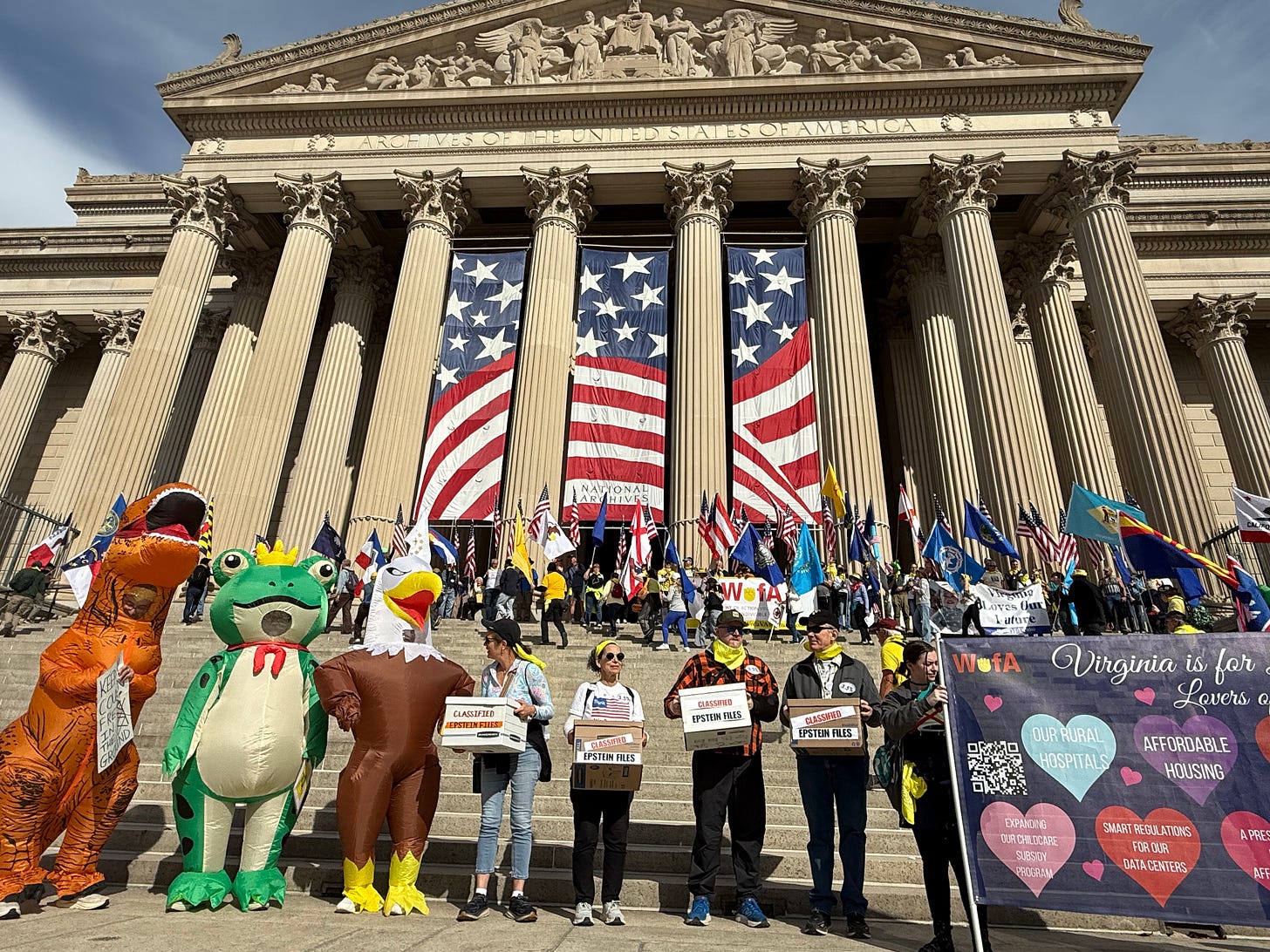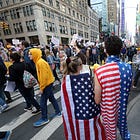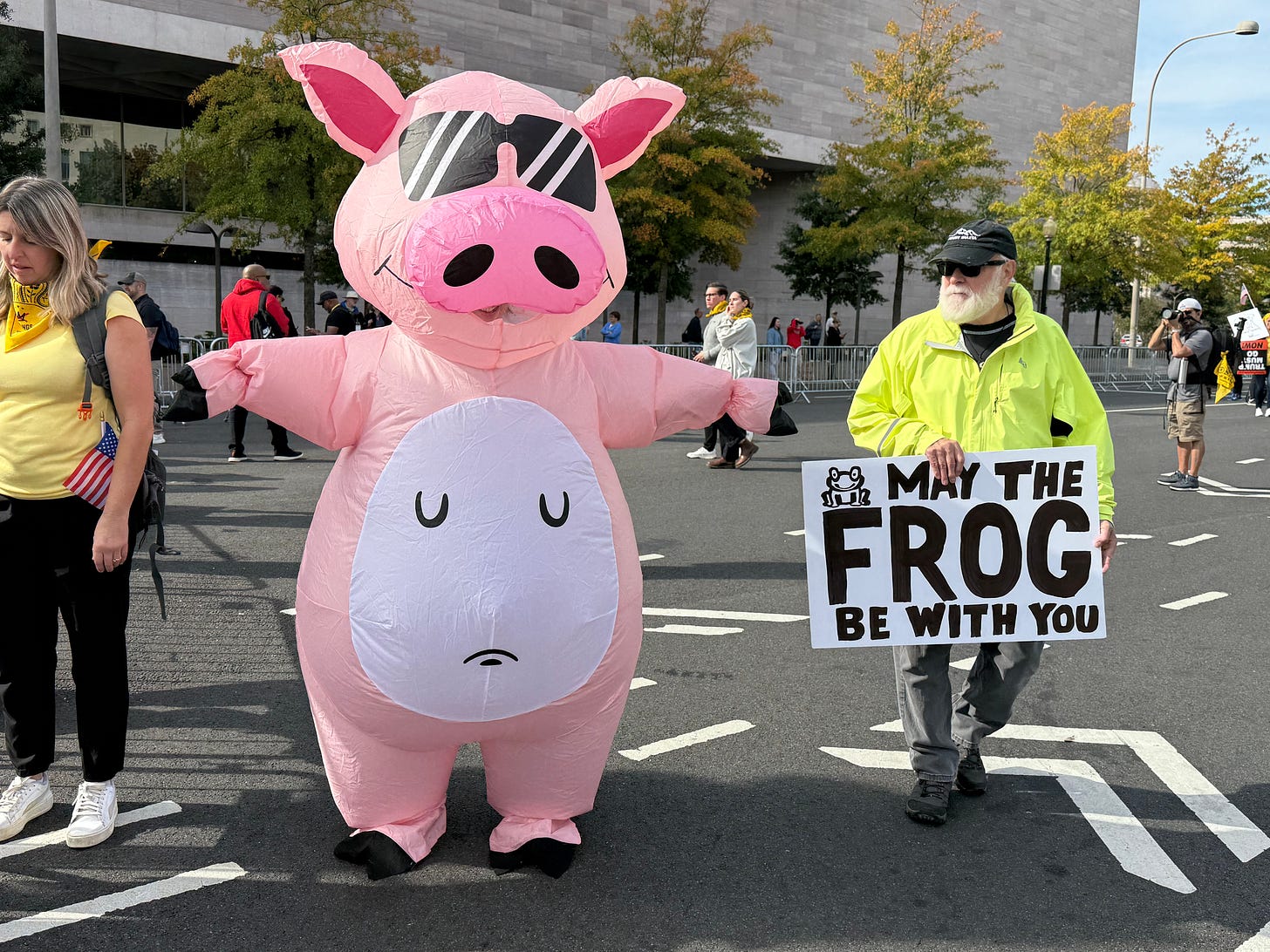The Paradox of No Kings Day
It was an outburst of catharsis. But will it lead to change?
As a lifelong D.C.-area resident, I’ve witnessed my fair share of protests: The Women’s March, the March for Our Lives, multiple Black Lives Matter protests, D.C. Pride, pro-Palestinian rallies, the list goes on. (In fact, I think the only major D.C.-based demonstration I’ve missed in the past decade is January 6.)
If you’ve ever asked yourself, what would it be like to attend all those events at once? then I have some unfortunate news—you just missed your chance.
This past Saturday, D.C. saw one of its largest demonstrations in recent memory: the No Kings rally to protest Donald Trump’s second administration. Organizers say that over 2,600 No Kings rallies were held across all 50 states, and there were likely millions of attendees nationwide.
My first reflection was that the title “No Kings”—though sharp and memorable—is not politically useful. To state the obvious, on a very literal level, the United States does not have a king, and suggesting otherwise could be perceived as insulting to the 77 million Americans who voted for Donald Trump. The name also appears to be causing confusion worldwide. Democrats Abroad, for instance, rebranded their iterations of the protest No Tyrants, “so as not to mix messages in a country with a monarchy.”
This is not to say that Trump doesn’t have some monarchical qualities; he certainly does. However—and this is my second concern with the name—if a MAGA Republican were to look at your anti-Trump slogan and say, sure, I agree with that, then perhaps it’s time to return to the drawing board.
Still, the name motivated a lot of compelling signage and patriotic rhetoric of the sort that has been sorely lacking from the left in recent years. Organizer-sponsored posters proclaimed “No Kings Since 1776,” people waved and distributed American flags, and plenty of homemade signs made reference to the Founding Fathers. Many attendees I spoke to cited the Constitution as their primary motivation for being there.
As will always be the case with large-scale demonstrations, not everyone stayed on theme. In fact, many attendees sported outdated and, dare I say, nostalgic branding from the 2010s. No Kings attracted pink pussy hats, Human Rights Campaign paraphernalia, and Black Lives Matter signage. I even spotted a bona fide vintage poster from the 2017 Women’s March. (There were fewer Palestinian flags than I expected, but that’s likely due to the recent ceasefire deal spearheaded by none other than the president himself.) And in case you were worried, Baby Trump was back and better than ever.
There were countless references to the Epstein files. Other protestors advocated for a “Free D.C.,” trans rights, science, abortion rights, Supreme Court reform, and the Equal Rights Amendment. There were climate groups, reproductive choice advocates, voting rights groups, labor unions, and immigration groups. The Democratic Socialists of America were represented, as was the Center for New Liberalism.
Ideologically overwhelmed yet?
One could find this inspiring, so many disparate causes united under one banner. But for those of us who want to see tangible reform in the United States, the lack of clear messaging or policy recommendations—especially during a protest intended to inspire action—was disorienting.
The two most high-profile political speakers were Senators Chris Murphy and Bernie Sanders. Murphy confidently stated that “we are not on the verge of an authoritarian takeover; we are in the midst of an authoritarian takeover,” and went on to list some of the Trump administration’s most egregious actions: the FCC’s targeting of Jimmy Kimmel, plain-clothes ICE agents snatching people off the street, repeated attacks on the free press. But he avoided any reference to specific actions or policy proposals that might push back against Trump’s overreach.
This contrasted with Sanders, who received, unsurprisingly, the biggest applause of the day, despite having the fewest Trump-specific remarks out of the many speakers. In fact, Sanders’s appearance was nearly indistinguishable from one of his 2020 campaign-trail stump speeches, rife with anti-billionaire rhetoric, attacks on Citizens United, and support for an expanded social safety net.
Is it any wonder that the speech that actually advocated for something, rather than simply being against Trump, was the most energizing?
There were countless notes of frivolity it would be tempting to complain about. The inflatable animal costumes. The inescapable phallic jabs at Trump. Even potty-mouthed Jesus and a left-wing January 6 Shaman.
But perhaps that would be overly cynical. Maybe this day—one filled with jubilation and camaraderie in addition to frustration—was exactly what America needed: chaotic, incoherent, unfiltered catharsis. Millions took to the streets and spent a day in unified pandemonium. Now they can put away their costumes and figure out how to move forward.
Last week, Speaker Mike Johnson said: “I bet you see pro-Hamas supporters, I bet you’ll see Antifa types, I bet you’ll see the Marxists in full display—the people who don’t want to stand and defend the foundational truths of this republic.” He was almost entirely incorrect.
Yes, there were a few idolizing references to Luigi Mangione. Some people carried Palestine flags (which does not mean they were “pro-Hamas” or supported globalizing the intifada). Plenty of harsh words were directed at Trump, JD Vance, Stephen Miller, Mike Johnson, Jeff Bezos, and other perceived enemies.
But the crowd—most of them—clearly loved this country. We can argue about the efficacy of their tactics, but their patriotism and loyalty were obvious.
I came to No Kings day with both an open mind and deep skepticism about the protest’s utility. I left with my skepticism unabated but my spirits lifted. Participation in the democratic process—which includes peaceful protest and civil disobedience—is the lifeblood of this country. I am heartened to know that such a spirit remains alive in the United States today.
Still, I can’t help but ask: What next?
Barrett Fife is on Persuasion’s Operations team.
Follow Persuasion on Twitter, LinkedIn, and YouTube to keep up with our latest articles, podcasts, and events, as well as updates from excellent writers across our network.
And, to receive pieces like this in your inbox and support our work, subscribe below:







I agree: we need a more coherent title and a message that goes beyond anti-"he who shall not be named." The Democratic Party seems reluctant or unable to articulate a set of principles that should guide us going forward. So it falls to the unelected leaders, perhaps, to begin to craft that message. One thing is for sure: if all we can do is march around in funny costumes carry signs, it won't win the hearts and minds of those who long for some substance not just performance.
I’m glad it was uplifting. I’m glad it wasn’t violent. I’m glad you enjoyed it. Those are all good things.
No Kings however, like McBeth, is a tale told by an idiot, full of sound and fury - signifying nothing.
Trump was unmoved. MAGA was unmoved. Were Independents unmoved? We’ll see.
Meanwhile, thanks to appeals, Trump will now send in the National Guard to Portland. ANTIFA will gleefully oblige. The Insurrection Act is being publicly floated. We can only guess where all this goes from here. Stay tuned.